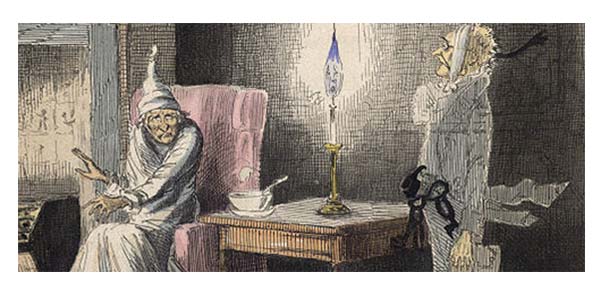
"Marley was dead, to begin with." Of course, it would be damned hard for a ghost story to have him still alive and kicking. Dragging chains, moaning like the voice of the sepulcher at the slightest perceived insult, and opening the window to show an impressive display of equally spectral figures would be enough proof of Marley being dead to me (I'm not terribly fond of looking out the window at night, anyway). Anyway, here is where the story and numerous films, TV adaptations, and parodies begins.
The Ghost of Christmas Present is a cross between Falstaff and Santa, so possibly a representation of Father Christmas, He shows Scrooge how the poor celebrate the holiday, Included here is his clerk's family, with a youngest son suffering some unmentioned but crippling and potentially fatal malady, whose fondest wish ('62 animated version) is for a bowl of razzleberry dressing.
The Ghost of Christmas Past is either a boyish girl or a girlish boy, and has a light emitting from his head (making him/her light-headed?), and shows the events of Scrooge's life that made him who he was, although not fully convincingly. So his girlfriend dumps him, hey Ebenezer, it happens to us all but doesn't make us become a greedy bastard! But I digress.
The Ghost of Christmas Yet To Come is a silent, wraith-like figure who likes to point (a local radio station version once had him able to speak, sounding like a stereotypical Mafioso). This chapter proves how incredibly thick Scrooge actually is. No sightings of his future self, people making rude comments about some recently deceased but nameless individual, suddenly we're in a cemetery. Who else would he find buried there?
So Scrooge is reformed and seeks to right all the wrongs he's done. Dickens also gets a bit preachy by saying Scrooge gave up spirits of both the supernatural and alcoholic variety. Earlier, he'd told Marley "There's more of gravy than the grave in you." Perhaps if the gravy consisted largely of brandy.
Incidentally (and risking becoming a bit preachy and digressive myself) I once knew a woman named Brandy on the Internet, and she disappeared into that mysterious void known as Real Life. That happens a lot on the Internet, where people are often fleeting images on a spectral screen, This becomes a bit unsettling when you find someone else with the same name.
One young woman I knew to be a lot of fun and very open about her "proclivities" seems to share a name with a woman I once saw on TV, paranoid and preparing for some unlikely doomsday. Another was a college student with a skill for baking and an interesting fashion sense having the same name as a cable news reporter. However the network bios showed the reporter to be at least 10 years older than the student. And given the unfortunate changes in the other, I'm not sure I want to know if I once knew her (although should the unlikely apocalypse happen, I sure hope -- but rather doubt -- if she'd let me into her bunker.)
The best versions of the story stick with the early-Victorian setting (although I did expect the George C Scott version to start channeling Patton and slap Tiny Tim). The musical Albert Finney version was okay, although the song "Thank You Very Much," can get annoyingly stuck in ones head. Alastair Sim was a fine Scrooge. But the animated 1962 Mr. Magoo version was the first I can remember watching and thus is my favorite. It is well-framed although changing the order of the Ghosts, and followed the classic musical comedy structure (including both a love song and a comedy song), and had nice Broadway-style songs -- from a top Broadway composer and lyricist. It is the only version I purchased on DVD, maybe nostalgia ... or perhaps something about that razzleberry dressing.

The Piker Press moderates all comments.
Click here for the commenting policy.